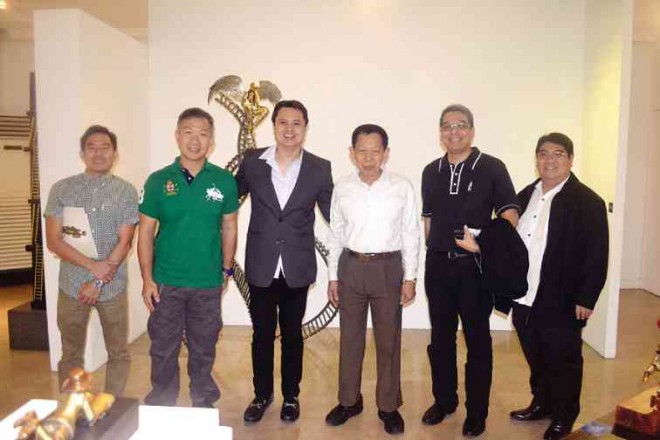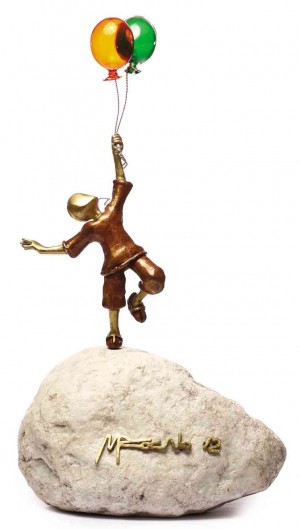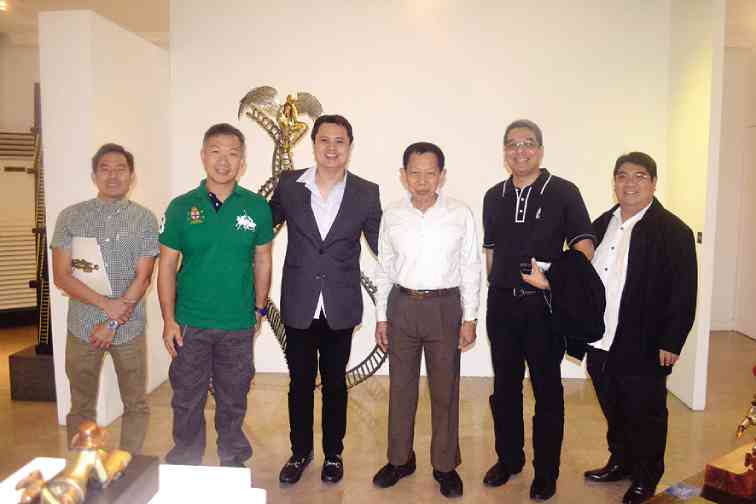
Exploring three-dimensional forms has been a creative preoccupation spanning almost two and a half decades for sculptor Michael Cacnio. Now 45 years old, he presents a summary of his multistoried artmaking in “Brass Act: Michael Cacnio at 45.”
The works have been culled largely from the Fatima University Gallery collection (the school runs the gallery as an adjunct to its Humanities program).
Cacnio’s oeuvre forms a cultural cache representing Filipino traditions and values, and contemporary realities.
The choice of brass, which has a long history as a medium in the traditional arts (for example, indigenous musical instruments and ornately crafted jewelry), takes on a further function in Cacnio’s aesthetic as a heritage material.
His method, too, of cutting and soldering seems a metaphor for the myriad influences that make up the Filipino psyche and image.

The blank faces of his subjects work very well because there is actually familiarity in anonymity—in their being featureless, they easily elicit empathy from viewers.
His followers and collectors will see in this celebratory miniretrospective his evolving use of brass. From pairings with wood and rock and moldings of fiberglass, to inclusions of elements from other media such as glass, semiprecious stones, electric lighting and even Lego blocks, his works are rich and varied.
Similarly in some instances, his Giacometti-inspired elongated figures have been joined by rotund physiques and smoother finishes.
Traditional games
Although he majored in Painting at University of the Philippines’ College of Fine Arts, Cacnio turned later to sculpture, initially exploring the native games of his Malabon boyhood.
“Luksong Baka” is similar to the Western leapfrog, rendered at the exact moment when the leaping boy is midair, suspended as if weightless, his legs spread and his hands on the back of the stooped playmate.
It is, however, the bobbing movement of long, curving brass lines that mimic kites soaring in “Saranggola” or fishing lines swaying with breezes in “Huli,” that enchanted his first collectors.
Following his tribute to guileless and innocent play was a salute to hardy labor that still hinted at his penchant for carefree play.
Cacnio did miniature sculptures of vendors and their carts, wares and various accoutrements. They come complete with removable lids as in “Magtataho;” opening door cages in “Bird Vendor;” and sometimes, even removable produce or products such as in “Mike’s Balls,” about a fishball vendor.
These toy-like details seem to also point to the artist’s own penchant for collectible action figures.
Cacnio has also paid tribute to parenthood (“Ligaya”) and religiosity (“Pasasalamat”). The Filipino extended family is the subject of the Christmas tribute “Mano Po,” showing a child pressing the back of his godparent’s hand to his forehead as a sign of respect before receiving his Christmas present.
Of course, Philippine Yuletide is best represented by the Star of Bethelem as symbolized by the parol or Christmas lantern, which Cacnio also has rendered in his sculptures.

Tribute to Angel Cacnio
Cacnio likewise pays tribute to his father, veteran painter Angel Cacnio. They collaborated on a work showing the boy Michael watching his dad working on a canvas.
Still linked to childhood is Cacnio’s partnership with Danish toy bricks company Lego. The collaboration was in celebration of his 20th year in the art industry when he showcased a recreation of “his trademark brass sculptures with the combination of Lego bricks that colored his childhood days.
The series balanced his traditional childhood with the contemporaneity that the Lego blocks represent.
Animation is skillfully implied by Cacnio in his use of glass blown to take the shape of balloons. In animated slapstick, a bunch of balloons pulls the holder upwards, resulting in amusingly precarious positions such as the man about to float up off a ladder in “Up-Float.”
Cacnio likewise tackles social commentary. In “Santong Kabayo,” the oxymoron is personified by a man who appears saintly with his palms clasped together in the attitude of prayer; yet from his backside sprouts a devil’s tail.
Meanwhile, his “Maldita” series consists of society women showing off their jewel-encrusted finery and garish affluence, pretty much looking like metal Barbie knockoffs.
Cacnio himself hand-painted the baro’t saya in some of these figures, embellishing some with brass appliqués and gems.
Said to evoke the Biblical Rapture, a 7 1/2-foot-tall man made of metal sticks is titled “Looking into Thy Self.” In the same way the structure is made brittle-looking by randomly bound sticks of metal, implying the dissolution of the physical with the soul’s ascent, the sticks become rungs for three curving ladders on the top of which an angel sits as “Overseer.”
On a darker note is “Google Earth” whose high-tech title is irony to the shanty roofs that are zoomed in on by the space satellite-powered app. The relief piece is most relevant in Internet-crazy but flash flood-stricken, climate change-ravaged Philippines.
“Brass Act: Michael Cacnio at 45” is on view at the NCCA Gallery, G/F, National Commission for Culture and the Arts, 633 Gen. Luna St., Intramuros, Manila, until Jan. 12. Call 5272192 or e-mail [email protected]. Visit www.ncca.gov.ph.















































